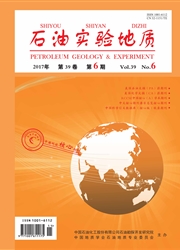

 中文摘要:
中文摘要:
全油样品的GC分析表明,塔里木盆地大宛齐油田不同层位的81个原油样品富含轻烃组分,且部分样品遭受了不同程度的微生物降解。以C4-C8轻烃地球化学参数为工具,对原油成熟度和次生蚀变等方面进行地球化学研究。轻烃成熟度参数表明,原油的折算Rc在0.9%左右,处于成熟阶段。对遭受生物降解作用的原油分析发现,随着生物降解作用的增强,其Mango轻烃参数K1值减小,K2值明显增大,甲基环己烷指数增大,甲基环戊烷较乙基环戊烷更容易遭受生物降解,表明单烷基环戊烷中烷基取代基越大的烃类越难遭受生物降解作用。结合轻烃参数指示的原油成熟度和母质来源,推测研究区原油为次生凝析油。通过轻烃参数对比研究发现,大宛齐油田凝析油轻烃参数特征与大北和其南部地区正常原油相似。依据塔里木盆地大宛齐油田的地质背景和原油成藏模式可知,研究区原油是大北和南部地区两类原油通过深大断裂运移到大宛齐浅部,通过蒸发分馏作用聚集成藏。
 英文摘要:
英文摘要:
The GC analysis of whole oil samples demonstrates that a suite of 81 crude oils from different production wells and reservoir horizons derived from the Dawanqi oil field contain a high abundance of light hydrocarbon, and partial oils were biodegraded to different degrees. C4-C8 light hydrocarbons were chosen for geochemical studies including oil maturity and secondary alteration. The maturity parameters of light hydrocarbons indicate that the calculated reflectance of oils was about 0.9%, suggesting condensates in the mature stage. For biodegraded oils, with biodegradation increasing, Mango's light hydrocarbon parameters K1 values reduce and K2 values increase remarkably. Furthermore, MCH index also increases. Methylcyclopentanes are depleted faster than ethylcyclopentanes, implying that there is a trend of lower susceptibility to biodegradation with greater alkyl substitution. Combined with maturity and organic matter input, it is speculated that oils in the Dawanqi oil field are secondary condensates. The comparison of light hydrocarbon parameters indicates that condensates in the Dawanqi oil field are consistent with crude oils from the Dabei oil field and the southern area of Dawanqi oil field. Based on the geological background of the Dawanqi oil field in Tarim Basin and the condensate accumulation pattern, it indicates that crude oils from the Dabei oil field and the southern area moved to the Dawanqi oil field through deep faults and underwent evaporative fractionation.
 同期刊论文项目
同期刊论文项目
 同项目期刊论文
同项目期刊论文
 期刊信息
期刊信息
